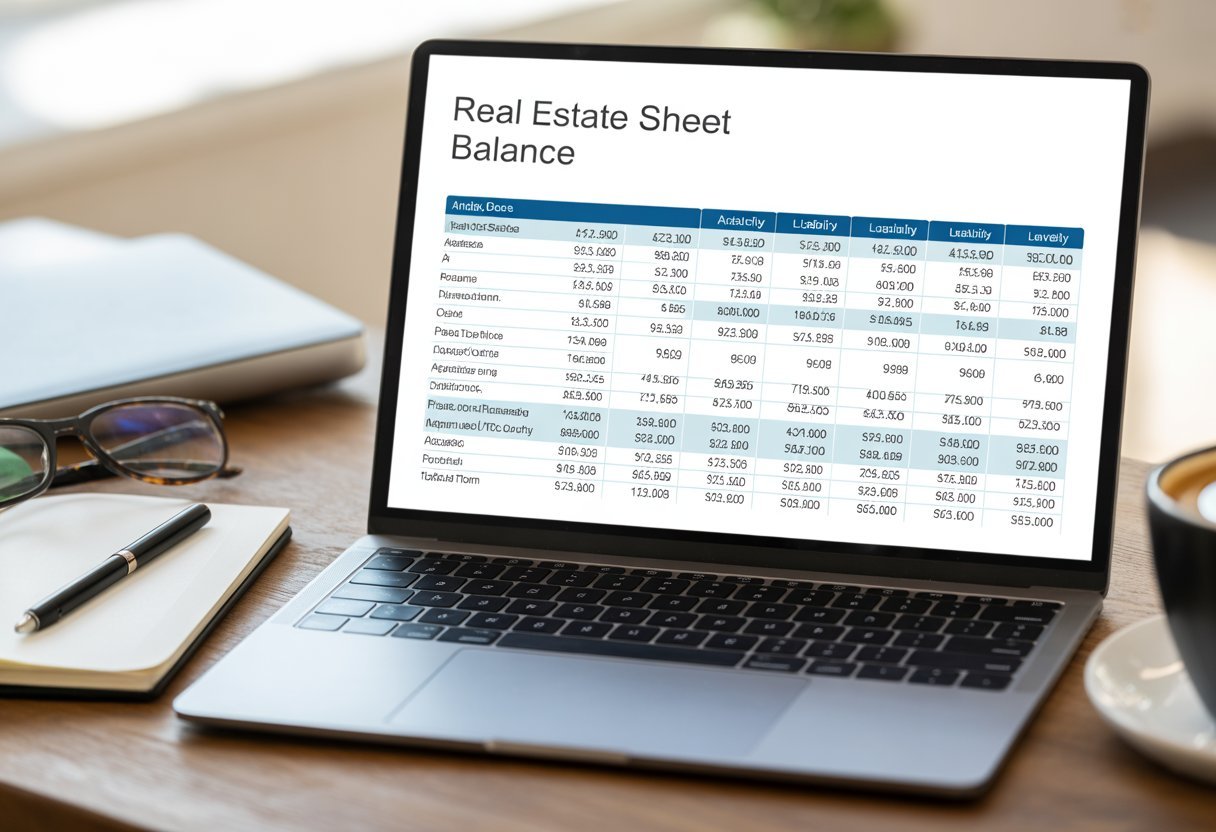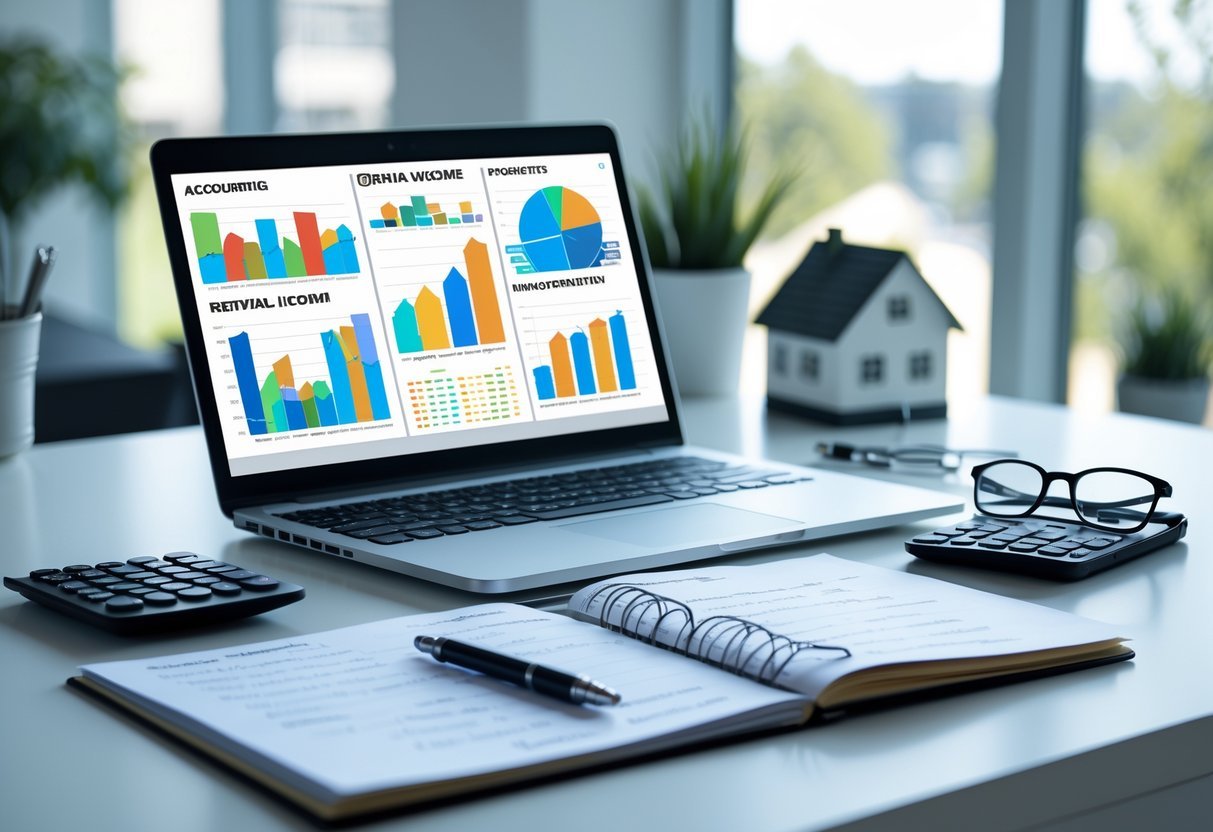Managing rental property finances can feel overwhelming, especially when tracking multiple income streams and expenses across different properties. A rental property chart of accounts provides the foundation for organizing every financial transaction related to your real estate investments.
Creating a properly structured chart of accounts helps you categorize income, expenses, assets, and liabilities while maintaining clear visibility into your rental property’s financial health. The right setup makes tax preparation easier, helps identify profit opportunities, and enables data-driven decisions about your investment portfolio.
Your chart of accounts acts as the backbone of your property management accounting system, organizing transactions into logical categories that align with both tax reporting requirements and business analysis needs. This systematic approach transforms complex financial data into actionable insights for growing your rental business.
Key Takeaways
- A well-organized chart of accounts provides essential structure for tracking rental property finances
- Strategic account categorization simplifies tax reporting and financial analysis
- Regular maintenance of your chart of accounts helps optimize property performance
What Is a Rental Property Chart of Accounts?
A rental property chart of accounts provides the foundation for tracking every financial aspect of your rental business. It’s a structured system that organizes all your financial transactions in one place.
Think of it as your financial filing cabinet, where you categorize income, expenses, assets, and liabilities specific to your rental properties. Each category gets its own “account” with a unique number for easy reference.
The chart helps you efficiently manage rental property finances by organizing key elements like:
- Rental income
- Security deposits
- Property maintenance costs
- Insurance expenses
- Mortgage payments
- Property management fees
- Utility bills
Your chart of accounts needs to align with standard accounting practices while being customized to your specific rental business needs. This ensures accurate financial reporting and simplified tax preparation.
Setting up a proper chart of accounts saves you time during tax season and helps track profitability for each property. It gives you clear insights into your cash flow and helps identify areas where you can reduce expenses.
Professional property managers use this system to maintain clean financial records and make informed business decisions. The structure allows you to quickly spot trends and address potential issues before they become problems.
Key Components of a Rental Property Chart of Accounts
A rental property chart of accounts template organizes your financial transactions into distinct categories that track money flowing in and out of your rental business. Each component serves a specific purpose in maintaining accurate financial records.
Income Accounts
Your rental income accounts track all money received from tenants and rental property operations. The primary account is Monthly Rent Revenue, which records regular rental payments from tenants.
Additional income sources to track include:
- Security deposits
- Late fees and penalties
- Pet rent and fees
- Parking fees
- Laundry and vending income
- Utility reimbursements
Expense Accounts
Property management expenses need careful categorization to maximize tax deductions and monitor costs.
Common expense categories include:
- Property Management Fees: 8-12% of monthly rent
- Maintenance & Repairs: Regular upkeep and fixes
- Insurance: Property and liability coverage
- Property Taxes: Annual or semi-annual payments
- Utilities: Water, gas, electric, garbage
- Marketing: Advertising vacant units
- Legal Fees: Tenant disputes and contracts
Asset Accounts
Asset accounts track items of value your rental business owns. The main asset is the property itself, recorded at purchase price.
Key asset accounts include:
- Bank Accounts: Operating and reserve funds
- Security Deposit Holdings: Tenant deposits held
- Property Value: Building and land cost
- Improvements: Major renovations that add value
- Equipment: Appliances and maintenance tools
Liability and Equity Accounts
Liability accounts track debts and obligations, while equity represents your ownership stake.
Primary liability accounts:
- Mortgage balance
- Property taxes due
- Security deposits owed
- Contractor invoices pending
- Insurance premiums payable
Equity accounts include:
- Initial investment
- Retained earnings
- Owner withdrawals
- Capital improvements
Setting Up a Chart of Accounts for Your Rental Properties
A well-structured chart of accounts creates a clear financial framework to track income, expenses, assets, and liabilities for each rental property. Proper categorization and organization enables accurate reporting and simplified tax preparation.
Defining Account Categories
Your rental property chart of accounts needs five main categories: Assets, Liabilities, Equity, Income, and Expenses. Each category requires specific subcategories to track different transaction types.
Essential Account Categories:
- Assets: Property value, security deposits held, bank accounts
- Liabilities: Mortgages, loans, tenant deposits owed
- Income: Rent payments, late fees, pet rent
- Expenses: Repairs, insurance, property management fees
- Equity: Owner investments, retained earnings
Create clear, descriptive account names that align with tax reporting requirements. Use consistent numbering like 1000 for assets, 2000 for liabilities, and so on.
Customizing for Different Property Types
Adapt your chart of accounts to match specific property characteristics and management needs. Single-family homes need different categories than multi-unit buildings.
Property-Specific Considerations:
- Separate utilities by unit for multi-family properties
- Track amenity fees for properties with pools or gyms
- Create distinct maintenance categories for different building systems
Add location-specific accounts if you own properties in multiple areas. This helps track regional expenses and income variations.
Use sub-accounts to organize expenses by property. For example, create separate repair accounts like “123 Main St – Repairs” and “456 Oak Ave – Repairs.”
Best Practices in Rental Property Accounting

Maintaining organized and accurate financial records is essential for successful rental property management. Proper accounting practices help maximize profits, simplify tax preparation, and provide clear insights into property performance.
Consistency in Account Structure
Creating a standardized chart of accounts helps you track income and expenses effectively across all your properties. Use consistent naming conventions and account codes for each property.
Your account structure should align with IRS reporting requirements, particularly Schedule E categories. This makes tax season much smoother.
Common account categories to include:
- Rental Income
- Security Deposits
- Maintenance Expenses
- Property Management Fees
- Insurance
- Property Taxes
Separation of Personal and Business Finances
Open dedicated bank accounts for your rental properties. Never mix personal and business transactions – this practice protects you legally and simplifies accounting.
Set up separate tracking for each property you own. This enables you to evaluate individual property performance and make informed investment decisions.
Consider using property management software to automatically categorize transactions and maintain clean financial records.
Regular Reconciliation
Review your accounts monthly to catch errors early. Compare bank statements against your recorded transactions to ensure accuracy.
Track these key items during reconciliation:
- Rent payments received
- Maintenance expenses paid
- Property management fees
- Utility payments
- Insurance premiums
Implement a system to monitor cash flow trends. This helps you identify potential issues before they become problems.
Keep digital copies of all receipts and invoices. Organize them by property and date for easy reference during tax preparation or audits.
Using Software Solutions for Rental Property Chart of Accounts
Modern accounting software streamlines financial tracking and reporting for rental property owners through automated categorization, custom templates, and specialized features designed for real estate.
QuickBooks for Rental Property Owners
Setting up QuickBooks for rental properties requires proper configuration of income and expense categories specific to real estate management.
You’ll need to create separate classes for each property to track performance individually. Your chart of accounts should include categories like rental income, security deposits, maintenance expenses, and mortgage interest.
QuickBooks Online allows you to customize reports showing profit and loss by property. The software automatically reconciles bank feeds and categorizes transactions based on rules you set.
Excel Templates for Chart of Accounts
Excel provides flexibility for creating a customized rental property accounting system. You can set up separate worksheets for each property and link them to a master dashboard.
Key components of an Excel-based chart of accounts include:
- Income categories (rent, late fees, utilities)
- Operating expenses (repairs, insurance, taxes)
- Fixed asset accounts (property value, improvements)
- Liability tracking (mortgages, security deposits)
Regular backup and manual data entry are required with Excel-based systems.
Specialized Accounting Software
Purpose-built rental property software offers features specifically designed for landlords and property managers.
These platforms typically include:
- Automated rent collection
- Property-specific expense tracking
- Built-in chart of accounts templates
- Tax preparation reports
Modern accounting solutions integrate with bank accounts and credit cards to automatically categorize transactions and generate real-time financial reports.
You can access your financial data from any device and share reports with tax professionals or property managers.
Analyzing and Optimizing Rental Property Financial Performance

Regular financial analysis helps identify opportunities to increase profitability and reduce costs in your rental property business. Proper tracking and evaluation of key metrics enables data-driven decisions about property improvements, rent adjustments, and future investments.
Tracking Cash Flow and Income Trends
Track your rental income systematically by recording all revenue streams, including monthly rent, late fees, and additional charges.
Create monthly cash flow statements to compare income versus expenses. Use spreadsheets or property management software to identify seasonal patterns and long-term trends.
Key metrics to monitor:
- Net Operating Income (NOI)
- Occupancy rates
- Rent collection rates
- Late payment frequency
- Year-over-year income growth
Assessing Maintenance and Operational Costs
Document all maintenance expenses in detail, categorizing them as routine, emergency, or preventive maintenance.
Track vendor costs and maintenance timing to identify potential cost-saving opportunities. Compare costs across similar properties to benchmark performance.
Cost categories to analyze:
- Repairs and maintenance
- Property management fees
- Insurance premiums
- Utility costs
- Property taxes
Evaluating Initial Investments and Returns
Calculate your return on investment using multiple metrics to get a complete picture of property performance.
Compare actual returns against your initial projections to refine future investment strategies.
Essential ROI calculations:
- Cash-on-cash return
- Capitalization rate
- Total return on investment
- Payback period
- Property appreciation rate
Review these metrics quarterly to identify necessary adjustments to your investment strategy or property management approach.
Common Pitfalls and How to Avoid Them
Proper account categorization and management of liability and equity accounts form the foundation of accurate rental property accounting. Mixing personal and business finances creates significant tax complications and makes tracking property performance impossible.
Improper Account Categorization
Not having a structured filing system leads to missed deductions and inaccurate financial reporting. Create separate categories for each property’s income and expenses.
Use dedicated software to track maintenance costs, utilities, and property management fees in distinct accounts. This prevents confusion during tax season and helps identify profit centers.
Keep meticulous records of security deposits, rent payments, and maintenance expenses. Never combine these with personal accounts or other investment vehicles.
Overlooking Liability and Equity Accounts
Your chart of accounts must include all mortgages, loans, and lines of credit associated with each property. Track principal and interest payments separately.
Monitor equity accounts carefully by recording owner contributions, distributions, and retained earnings. This gives you a clear picture of your investment returns.
Set up specific accounts for security deposit liabilities and unearned rent. These items affect your tax obligations and must be properly categorized as liabilities until earned or returned.
Create separate accounts for property management fees and contractor payments to maintain clear oversight of third-party obligations.
Frequently Asked Questions
A well-structured chart of accounts forms the foundation for tracking rental property finances and streamlining tax preparation. Professional property managers and real estate investors rely on standardized account categories to maintain accurate financial records.
What are the essential accounts to include in a chart of accounts for rental property?
Essential rental property accounts must include income categories like rent payments, late fees, and security deposits.
Your expense accounts should track repairs, maintenance, property management fees, insurance, and utilities.
Balance sheet accounts need to include assets like buildings and improvements, as well as liabilities such as mortgages and security deposit holdings.
How do you structure a real estate chart of accounts for a property management company?
Property management companies require specific account structures that separate each property as a distinct profit center.
Create main categories for assets, liabilities, income, and expenses, then use sub-accounts for individual properties.
Use numbered accounts starting with unique identifiers for each property to keep transactions organized.
Can you provide an example of a chart of accounts tailored for short-term rental properties?
Short-term rental accounts should track cleaning fees, booking platform commissions, and amenity expenses separately.
Create specific income accounts for nightly rates, cleaning charges, and additional guest fees.
Include expense categories for supplies, turnover costs, and platform listing fees.
What are some best practices for categorizing expenses in rental property accounting?
Create detailed sub-categories for major expense types like repairs, maintenance, and improvements.
Keep tax-deductible expenses separate from capital improvements and personal expenses.
Use consistent naming conventions across all properties to simplify reporting and analysis.
How can I adapt my QuickBooks for managing a rental property chart of accounts?
Set up classes in QuickBooks to track individual properties separately.
Customize your default chart of accounts by adding property-specific income and expense categories.
Use sub-accounts to organize property-related transactions within main account categories.
Where can I find a template for a chart of accounts specific to real estate management?
Download professional templates from property management software providers.
Modify existing templates to match your specific property portfolio needs and management structure.
Consider consulting with a real estate accountant to ensure your chart of accounts aligns with tax reporting requirements.




